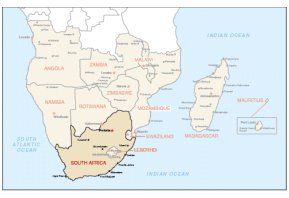

Market of the Month – Sub-Saharan Africa
South Africa

|
South Africa Market Brief – Audio File South Africa Market Brief – Transcript
|
In the 12 years since the historic first general elections that resulted in democracy, South Africa has become a political and economic success story. With a stable political system, robust civil institutions, a consistent growth rate and very respectable investment ratings, South Africa has enjoyed due attention by U.S. businesses. South Africa is unlike the rest of Africa. With first-world infrastructure, communications and tertiary industries, South Africa is eminently placed to lead the whole southern African region to the next level in international trade and commercial opportunities.
There are already over 600 U.S. companies represented in South Africa. Established and new U.S. entrants need to carefully explore and develop the local market for outright sales, joint venture and licensing opportunities. At the same time, the country is a logical site for global corporate positioning on the final commercial frontier, the African continent.
Opportunities for U.S. exporters and investors in South Africa reflect the growth of its consumer base and its efforts to upgrade and develop its infrastructure to match and further fuel its economic growth.
Factors benefiting U.S. exporters include the following:
 | Very strong retail environment, expected to last for at least two years |
 | Currency that has increased in value to the trade-weighted basket by 17% since December 2003, and now again favors many manufactured imports |
 | Increasing market share for U.S. branded goods |
 | Planned increase in capital expenditures by the South African government-owned, corporatized, parastatal utilities such as ESKOM (energy) and TRANSNET (transportation)—set for $20 billion over the next five years |
 | South Africa’s selection as host of the 2010 FIFA World Cup soccer championship—expected to result in $350 million in improvements and investment projects |
Population: 47,900,000
Form of Statehood: Republic, since 1961
Government: Democracy, since 1994
Literacy: 86%
Total Area: 1.22 million square kilometers (slightly less than twice the size of Texas)
Nominal GDP: US$135 billion (approx the same as South Carolina)
Natural Resources: Platinum group metals (PGMs), gold, base metals, chromium, manganese, titanium, uranium, diamonds, coal
Primary Industries: Ore and mineral extraction, agricultural produce (including fishing)
Secondary Industries: Food and beverages, ore and mineral benefication, hydrocarbon into petroleum and plastics conversion, iron and steel, machinery, automotive
Main Export Partners: United States 27%, United Kingdom 12%, Germany 10%, Japan 10%, Italy 6%, other 25%

Best Prospects for U.S. Exporters
In general, the best prospects for exports are in capital goods, though opportunity exists in a wide range of consumer products and services as well. Of particular note are the following:
 | Airport/Ground Support Equipment |
 | Telecommunications Equipment |
 | Electric Power Systems |
 | Medical Equipment |
 | Automotive Parts/Service Equipment |
 | Pollution Control Equipment |
 | Healthcare Services |
Because the South African market is sophisticated, entry should be well-planned, and businesses should factor in the following challenges:
 | Very skewed demographic income distribution pattern, where 10% of the population earns 45% of the national income |
 | Market in which the majority of consumer demand is very price sensitive |
 | Distribution issues, where the large retail centers are spread over only five metropolitan regions |
 | Need for sustained market development, due to the entrenched bias of a conservative market that sticks to known suppliers |
U.S. firms should judiciously select one of three low-risk entry strategies: representation, agency or distributorship. They should also ensure that any local partner is compliant with Black Economic Empowerment (BEE). South Africa is the pre-eminent stepping stone for developing most sectors in sub-Saharan Africa. The marketing mix should anticipate this medium-term option.
The Commercial Section of the U.S. Embassy in South Africa offers a range of services to U.S. firms interested in doing business in Southern Africa, as well as to South African firms interested in importing U.S. products and services. The Commercial Service Southern Africa can assist U.S. firms with doing business in Angola, Botswana, Lesotho, Madagascar, Malawi, Mozambique, Mauritius, Namibia, Swaziland, Zambia and Zimbabwe.
For U.S. firms, commercial specialists can help you identify and find trade opportunities and local trading partners, provide market research and launch your company in the Southern African market. With an active trade events schedule, advocacy support and export assistance can be provided to U.S. firms doing business in Southern Africa.
http://www.buyusa.gov/southafrica/en/upcomingevents.html
For more information, visit the U.S. Embassy South Africa Website: http://www.buyusa.gov/southafrica/en/.
